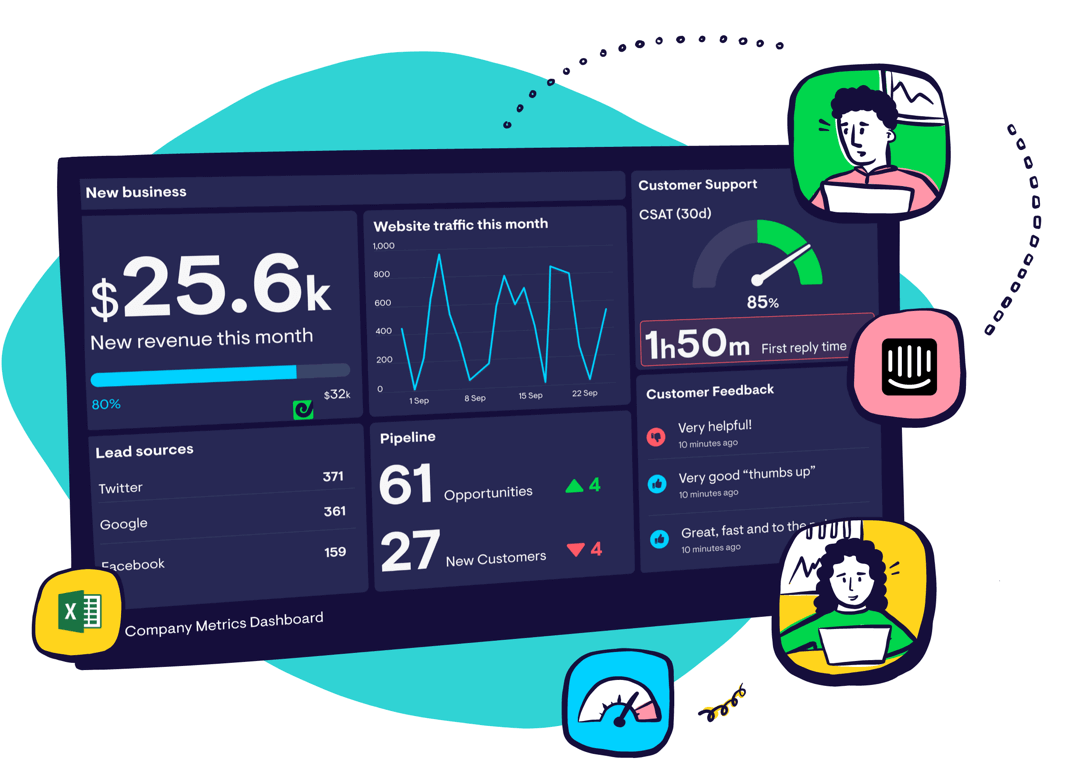Pipeline Volume vs Goal
What is Pipeline Volume vs Goal?
The sales metric Pipeline Volume vs Goal compares the number of leads in your sales pipeline to your target goal (the number leads required to hit your quota). This is a more complex KPI made up of a combination of sales metrics - one for each stage of your sales pipeline. Note: you’ll need to know your conversion rates for each stage of your pipeline.
How to calculate Pipeline Volume vs Goal:
Step 1: Define each stage in your sales pipeline. For this example, we’ll use the following stages.
- Marketing Qualified Lead (MQL)
- Sales Qualified Lead (SQL)
- Sales Accepted Lead (SAL)
- Deals Won
Step 2: Calculate the conversion rate between each stage.
(#) of SQLs / (#) of MQLs = (#) MQL to SQL Conversion Rate
- SQL to SAL Conversion Rate:
(#) of SALs / (#) of SQL = (#) SQL to SAL Conversion Rate
- SAL to Win Conversion Rate:
(#) of Deals Won / (#) of SAL = (#) Win Conversion Rate
Step 3: Calculate your goal for (#) of deals won. Note: see here for directions on how to calculate Average Purchase Value.
($) Monthly Revenue Goal / ($) Average Purchase Value = (#) Deals Won Goal
Step 4: Work backwards to calculate the Pipeline Volume Goal for each stage.
(#) Deals Won Goal / (#) Win Conv Rate = (#) SAL Vol Goal
(#) SAL Vol Goal / (#) SQL to SAL Conv Rate = (#) SQL Vol Goal
(#) SQL Vol Goal / (#) MQL to SQL Conv Rate = (#) MQL Vol Goal
Example:
Since this is a more complex sales metric, here is an example calculation that illustrates the above steps. (We won’t calculate the actual conversion rates since a more detailed explanation can be found here for MQL to SQL Conversion Rates and here for SQL to Win Conversion Rates.)
-
$20,000 (Monthly Revenue Goal) / $2,000 (Average Purchase Value) = 10 (Deals Won Goal)
- 10 (Deals Won Goal) / 20% (Win Conv Rate) = 50 SAL Volume Goal
- 50 (SAL Vol Goal) / 50% (SQL to SAL Conv Rate) = 100 SQL Vol Goal
- 100 (SQL Vol Goal) / 10% (MQL to SQL Conv Rate) = 1,000 MQL Vol Goal
Pros:
Pipeline Volume vs Goal is a leading KPI that helps you proactively determine if you’re on track to meet your sales quota. By identifying the goal for each stage, you can easily see gaps in the pipeline and make the necessary adjustments to resume hitting your overall revenue goals.
Over time, you may need to adjust the goal for each stage as your conversion rate changes and revenue goals increase. Managing your pipeline is an ongoing process and should involve regular reviews.
Cons:
While Pipeline Volume vs Goal is a great leading KPI, it only shows an aspect of your overall sales progress. You’ll want to track this sales metric alongside other lagging indicators such as Monthly Revenue, Average Deal Size, and Average Sales Cycle Length.
Relevant Sales Metrics:
If you’re adding Pipeline Volume vs Goal to your sales KPI dashboard, you might want to also consider tracking these related sales metrics for context.
Industry Benchmarks and Examples
Pipeline Volume vs Goal will vary widely based on company, industry, and product/service. It’s best to use the benchmarks for MQL to SQL Conversion Rate and SQL to Win Conversion Rate to calculate what your pipeline volume should be at each stage.
Additional Notes:
If you’re just starting out and don’t have consistent conversion rates yet, you can also calculate your pipeline volume by weighting each stage and using closing probability benchmarks (called a Weighted Sales Pipeline). This post by Pipeliner CRM Blog explains the process in detail.
